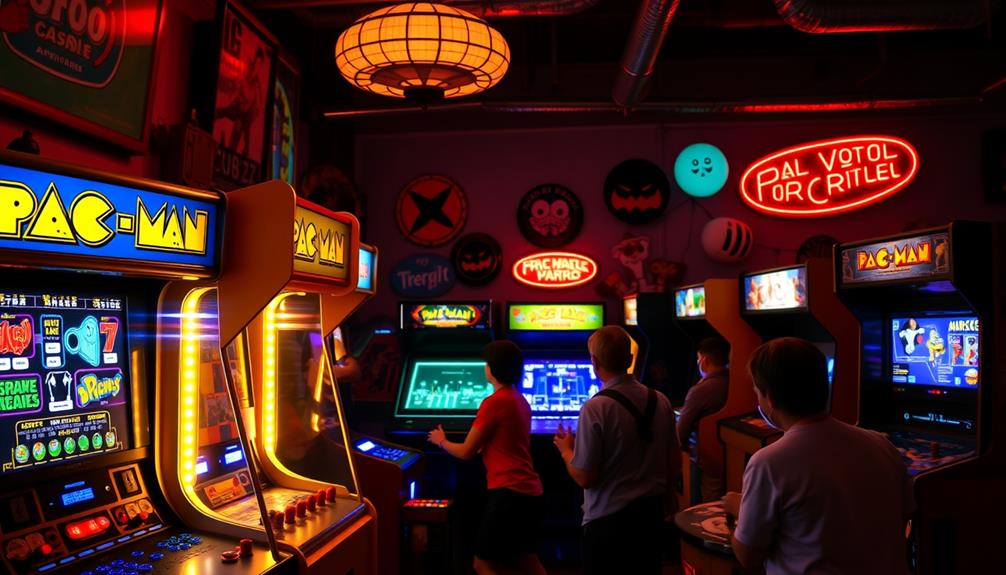Arcade games are created by combining design, programming, and sound integration. It all begins with a solid concept that shapes the gameplay. Developers then write millions of lines of code in assembly language to ensure optimal performance. They design graphics and animations specifically for arcade hardware, while sound engineers create immersive audio that complements the game’s action. Thorough testing ensures everything functions smoothly. Games are then distributed to locations, where operators ensure they operate at their best. If you’re interested in learning more about each stage of the process, there is a lot to discover about the world of arcade game development.
Key Takeaways
- Development starts with a solid concept outlining gameplay mechanics and objectives, guiding the entire creation process.
- Programmers utilize assembly language for hardware control, optimizing memory and performance in arcade systems.
- Graphics and animations are crafted using specialized tools, focusing on pixel art that aligns with the game's theme.
- Sound engineers create custom audio, integrating sound effects that sync with game events for an immersive experience.
- Extensive testing and debugging are conducted to ensure stability and playability before public deployment of the game.
History of Arcade Games
Arcade games have a fascinating history that dates back to the vibrant public venues of the 1970s and 1980s. The journey began with the first arcade games like "Computer Space," launched in 1971 by Nolan Bushnell and Ted Dabney. This groundbreaking title paved the way for the burgeoning arcade industry.
Just a year later, Atari released "Pong," which became the first commercially successful arcade game, igniting a gaming revolution. With advancements in technology, arcade machines began to incorporate more complex graphics and sound, enhancing player experiences and engagement in ways previously unimagined.
During the Golden Age of Arcade Games from 1978 to 1982, iconic titles like "Pac-Man," "Donkey Kong," and "Asteroids" captivated players and filled arcade cabinets in restaurants and pubs. These games relied on innovative game logic and arcade hardware, creating immersive experiences that drew crowds. Coin-operated machines became a staple in entertainment venues, marking a shift in how people enjoyed leisure time.
For instance, the evolution of arcade machines has led to best arcade machines for home game rooms being designed for modern gamers. However, by the late 1980s, the rise of home video game consoles began to overshadow arcade games.
Despite this decline, a recent resurgence in interest for classic arcade games has emerged, sparking nostalgia and bringing players back to those thrilling, coin-operated machines. The history of arcade games is a reflection of their lasting impact on gaming culture.
Programming Arcade Games

While developing arcade games, programmers face unique challenges that require a blend of creativity and technical skill. The programming of the game often starts with writing in assembly language, which provides precise control over hardware components and memory. This is essential for optimizing performance and guaranteeing a seamless gaming experience.
To create an engaging atmosphere, game developers might also draw inspiration from uplifting music, such as Blue Skies and Lemonade by Rhythm Failure, which evokes feelings of joy and nostalgia.
As you immerse yourself in the coding phase, you'll be writing millions of lines of code to manage game logic, graphics, and sound design. Integrating graphics and sound is significant, and you'll likely use specialized tools to create pixel art and implement audio features tailored for arcade systems. Each element must work together to keep players engaged and entertained, especially when it comes to thrilling moments like the coin drop.
Extensive testing and debugging are critical to guarantee stability and playability, as these games are deployed in public venues where reliability is key. A well-tested game can lead to commercial success, attracting more players and generating revenue.
Game Development Process

Creating an arcade game involves a structured game development process that starts with a solid concept. Designers outline the gameplay mechanics and objectives, defining what makes your game unique before any programming kicks off. Next, developers create a storyboard to map out the game’s progression and visual style. The history of arcade games can provide inspiration for classic gameplay elements, as well as modern twists on familiar concepts. By drawing on the history of arcade games, developers can pay homage to the industry’s roots while still creating something fresh and innovative. This process of research and brainstorming is crucial for ensuring that the final product offers a balance of nostalgia and originality.
After establishing the concept, you'll create prototypes to test these mechanics, gathering valuable feedback to refine your ideas. This iterative process is similar to how top-rated pinball machines are developed, focusing on gameplay and features to enhance player engagement and replay value, as seen in best rated pinball machines.
Once the gameplay is solidified, programmers begin writing the source code that controls the game's elements, including logic and graphics. This stage often sees close collaboration between designers and programmers to guarantee the game aligns with the initial vision.
Graphics and animations are crafted using specialized tools, tailored to fit the capabilities of the arcade hardware, assuring a visually appealing experience.
As development progresses, extensive testing and debugging become essential. You'll need to identify and fix any bugs, guaranteeing the game is stable and playable before it reaches the arcade.
This meticulous attention to detail helps create an engaging experience for players, setting the stage for a successful launch. To sum up, the game development process is a collaborative effort that transforms ideas into a fully functional arcade game, ready to entertain.
Sound and Graphics Integration

Integrating sound and graphics is essential for delivering an engaging arcade game experience. Sound engineers and composers create custom sound and music, often using dedicated sound chips for audio playback. Programmers then write code that triggers audio based on game events, guaranteeing the sounds sync perfectly with the action.
On the graphics side, designers focus on pixel art and animations, using specialized tools that maximize the limited graphical capabilities of arcade machines. Visual elements like sprites and backgrounds are meticulously crafted to align with the game's theme, enhancing the immersive player experience.
Here's a quick look at the integration process:
| Component | Description |
|---|---|
| Sound Integration | Utilizes sound chips for audio playback, linked to game events. |
| Graphics Design | Involves pixel art and animations, aligning with the game's mechanics. |
| Testing & Stability | Extensive testing guarantees compatibility and performance stability. |
Distribution and Maintenance

Once the sound and graphics are seamlessly integrated, the focus shifts to how these completed arcade games reach players and stay operational. Distribution typically involves the physical delivery of game boards or entire cabinets to gaming venues, guaranteeing they're ready for public play.
Operators play a significant role in this process, as they're responsible for placing these games in locations where players can easily access them. Similar to the cruise industry where operators guarantee a seamless experience for guests, successful arcade game distribution requires strategic placement and consideration of the target audience luxury cruises provide exclusive amenities.
Once the games are set up, ongoing maintenance becomes essential. Regular updates and bug fixes are necessary to maintain performance and keep players engaged. Stability and reliability are fundamental in public gaming environments, so routine checks and repairs are a priority for arcade operators.
With advancements in technology, the maintenance of modern arcade games has become more efficient. Many now leverage PC-based platforms, which streamline both development and maintenance processes, allowing for quicker game interchange.
Operators must stay proactive in addressing any issues, guaranteeing that players always have a smooth gaming experience. By understanding the importance of both distribution and maintenance, you can appreciate the effort that goes into keeping arcade games alive and thriving in today's entertainment landscape.
Frequently Asked Questions
How Do They Make Arcade Games?
To make arcade games, you start with an idea, create a prototype, then write code for gameplay and graphics. You'll test extensively, ensuring everything's stable before delivering the final product to the arcade.
What System Do Arcade Games Use?
Arcade games typically use dedicated hardware systems, often running on modern operating systems like Linux or Windows. They may also utilize older systems like DOS, depending on the specific requirements and performance needed for the game.
What Were Arcade Games Coded In?
You might think arcade games were coded in some magical language, but they actually relied on assembly language. This gave developers tight control over hardware, creating engaging experiences despite the limitations of early technology.
Are Arcade Video Games Still Made?
Yes, arcade video games are still made. You'll find modern titles with advanced technology and interactive features, blending nostalgia with innovation. Companies keep releasing new games, ensuring the arcade experience remains exciting and engaging for everyone.
Conclusion
In the world of arcade games, every pixel and sound comes together like a symphony, creating an experience that captivates players. By understanding the intricate processes behind these beloved games, you can appreciate the artistry and effort that goes into them. Whether you're designing your own game or just enjoying a classic, remember that each arcade adventure is a tribute to creativity and innovation, bringing joy to countless players across generations. So, plunge into and enjoy the ride! If you want to experience the thrill of arcade games without the commitment of purchasing one, consider renting arcade games for your next event or party. This allows you to enjoy a variety of games without the cost of buying each one individually. Renting arcade games can also provide a fun and nostalgic activity for guests of all ages, creating a memorable and exciting atmosphere. So, why not bring the arcade experience to your next gathering and let the good times roll?









